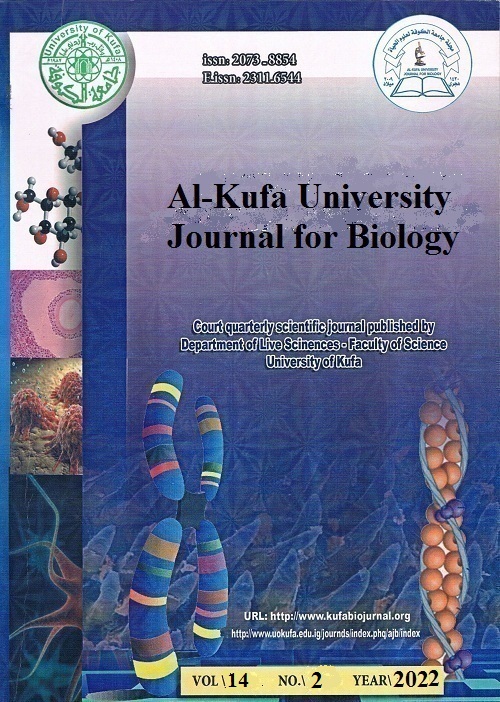Evaluation of mutations in DHCR7 gene in high-risk pregnant women for Smith Lemli Opitz Syndrome during second-trimester screening in Nasiriyah
DOI:
https://doi.org/10.36320/ajb/v14.i2.11707Keywords:
SLOS, DHCR7, Smith Lemli Opitz Syndrome, mutationAbstract
Introduction: Smith Lemli Opitz Syndrome (SLOS) is the second most frequent metabolic disease in various populations. At the end of the cholesterol production pathway, a mutation in the dehydrocholesterol reductase (DHCR7) gene causes SLOS. DHCR7 is a membrane protein that needs the cofactor NADPH to function. In SLOS patients, more than 130 distinct DHCR7 mutations have been discovered. The impact of the DHCR7 gene mutation on the severity and symptoms of SLOS in patients, particularly high-risk pregnant women, has been recommended.
Methods: This study was performed on 20 high-risk pregnant women with SLOS at a second-trimester screening in the Nasiriyah. To detect DHCR7 gene mutations in infected individuals, DNA was collected from peripheral blood, and Sanger sequencing was performed.
Result: 20 women suspected of having SLOS with 26.7 ±8.01 years old (SD) were included. 70% (14) of families had a history of having a child with SLOS disorder. In contrast, the 30 % (6) remaining families had never had SLOS before and were discovered during pregnancy. Only 4 pregnant women (20%) identified with DHCR7 mutation. The DHCR7 gene was analyzed from exons 1 to 9, and a c.445C> T (CAA-TAA) mutation was detected in exon 6 of this gene.
Conclusion: According to the findings of prior studies and the present study, the sequencing of the DHCR7 gene can detect around 96 percent of known variations and pathogens; therefore, the identification and analysis of the DHCR7 gene during pregnancy and screening for SLOS may be claimed to be beneficial.
Downloads
References
Nowaczyk MJM, Waye JS, Douketis JD. DHCR7 mutation carrier rates and prevalence of the RSH/Smith‐Lemli‐Opitz syndrome: where are the patients? Am J Med Genet Part A. 2006;140(19):2057–62. DOI: https://doi.org/10.1002/ajmg.a.31413
Nowaczyk MJM, Irons MB. Smith–Lemli–Opitz syndrome: phenotype, natural history, and epidemiology. In: American Journal of Medical Genetics Part C: Seminars in Medical Genetics. Wiley Online Library; 2012. p. 250–62. DOI: https://doi.org/10.1002/ajmg.c.31343
Rojare C, Opdenakker Y, Laborde A, Nicot R, Mention K, Ferri J. The Smith–Lemli–Opitz syndrome and dentofacial anomalies diagnostic: Case reports and literature review. Int Orthod. 2019;17(2):375–83. DOI: https://doi.org/10.1016/j.ortho.2019.03.020
DeBarber AE, Eroglu Y, Merkens LS, Pappu AS, Steiner RD. Smith–Lemli–Opitz syndrome. Expert Rev Mol Med. 2011;13. DOI: https://doi.org/10.1017/S146239941100189X
Kelley RI, Hennekam RCM. The smith-lemli-opitz syndrome. J Med Genet. 2000;37(5):321–35. DOI: https://doi.org/10.1136/jmg.37.5.321
Haas D, Garbade SF, Vohwinkel C, Muschol N, Trefz FK, Penzien JM, et al. Effects of cholesterol and simvastatin treatment in patients with Smith–Lemli–Opitz syndrome (SLOS). J Inherit Metab Dis Off J Soc Study Inborn Errors Metab. 2007;30(3):375–87. DOI: https://doi.org/10.1007/s10545-007-0537-7
Bianconi SE, Conley SK, Keil MF, Sinaii N, Rother KI, Porter FD, et al. Adrenal function in Smith–Lemli–Opitz syndrome. Am J Med Genet Part A. 2011;155(11):2732–8. DOI: https://doi.org/10.1002/ajmg.a.34271
Temple SEL, Sachdev R, Ellaway C. Familial DHCR7 genotype presenting as a very mild form of Smith‐Lemli‐Opitz syndrome and lethal holoprosencephaly. JIMD Rep. 2020;56(1):3–8. DOI: https://doi.org/10.1002/jmd2.12155
Lazarin GA, Haque IS, Evans EA, Goldberg JD. Smith–Lemli–Opitz syndrome carrier frequency and estimates of in utero mortality rates. Prenat Diagn. 2017;37(4):350–5. DOI: https://doi.org/10.1002/pd.5018
Witsch‐Baumgartner M, Löffler J, Utermann G. Mutations in the human DHCR7 gene. Hum Mutat. 2001;17(3):172–82. DOI: https://doi.org/10.1002/humu.2
Wilkins-Haug L. Genetic innovations and our understanding of stillbirth. Hum Genet [Internet]. 2020;139(9):1161–72. Available from: https://doi.org/10.1007/s00439-020-02146-2 DOI: https://doi.org/10.1007/s00439-020-02146-2
Witsch-Baumgartner M, Ciara E, Löffler J, Menzel HJ, Seedorf U, Burn J, et al. Frequency gradients of DHCR7 mutations in patients with Smith-Lemli-Opitz syndrome in Europe: evidence for different origins of common mutations. Eur J Hum Genet. 2001;9(1):45–50. DOI: https://doi.org/10.1038/sj.ejhg.5200579
Begic N, Begic Z, Begic E. Smith-Lemli-Opitz syndrome: Bosnian and Herzegovinian experience. Balk J Med Genet. 2021;24(1):99–102. DOI: https://doi.org/10.2478/bjmg-2021-0002
Schoner K, Witsch‐Baumgartner M, Behunova J, Petrovic R, Bald R, Kircher SG, et al. Smith‐Lemli‐Opitz syndrome—Fetal phenotypes with special reference to the syndrome‐specific internal malformation pattern. Birth defects Res. 2020;112(2):175–85. DOI: https://doi.org/10.1002/bdr2.1620
Daum H, Meiner V, Michaelson-Cohen R, Sukenik-Halevy R, Zalcberg ML, Bar-Ziv A, et al. Smith–Lemli–Opitz syndrome: what is the actual risk for couples carriers of the DHCR7: c. 964-1G> C variant? Eur J Hum Genet. 2020;28(7):938–42. DOI: https://doi.org/10.1038/s41431-020-0577-0
Jayamanne C, Sandamal S, Jayasundara K, Saranavabavananthan M, Mettananda S. Smith–Lemli–Opitz syndrome presenting as acute adrenal crisis in a child: a case report. J Med Case Rep [Internet]. 2018;12(1):217. Available from: https://doi.org/10.1186/s13256-018-1738-4 DOI: https://doi.org/10.1186/s13256-018-1738-4
Kelley RI. Diagnosis of Smith-Lemli-Opitz syndrome by gas chromatography/mass spectrometry of 7-dehydrocholesterol in plasma, amniotic fluid and cultured skin fibroblasts. Clin Chim acta. 1995;236(1):45–58. DOI: https://doi.org/10.1016/0009-8981(95)06038-4
Waye JS, Eng B, Nowaczyk MJM. Prenatal diagnosis of Smith‐Lemli‐Opitz syndrome (SLOS) by DHCR7 mutation analysis. Prenat Diagnosis Publ Affil With Int Soc Prenat Diagnosis. 2007;27(7):638–40. DOI: https://doi.org/10.1002/pd.1735
Published
How to Cite
Issue
Section
License
Copyright (c) 2022 Al-Soofi, Roya Zekavati, Mohammadi-Asl

This work is licensed under a Creative Commons Attribution 4.0 International License.
which allows users to copy, create extracts, abstracts, and new works from the Article, alter and revise the Article, and make commercial use of the Article (including reuse and/or resale of the Article by commercial entities), provided the user gives appropriate credit (with a link to the formal publication through the relevant DOI), provides a link to the license, indicates if changes were made and the licensor is not represented as endorsing the use made of the work.












